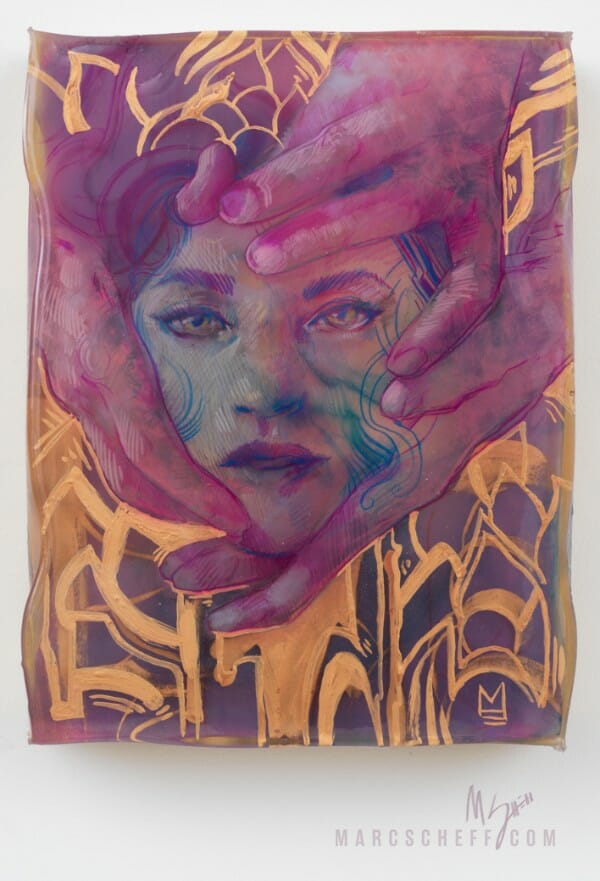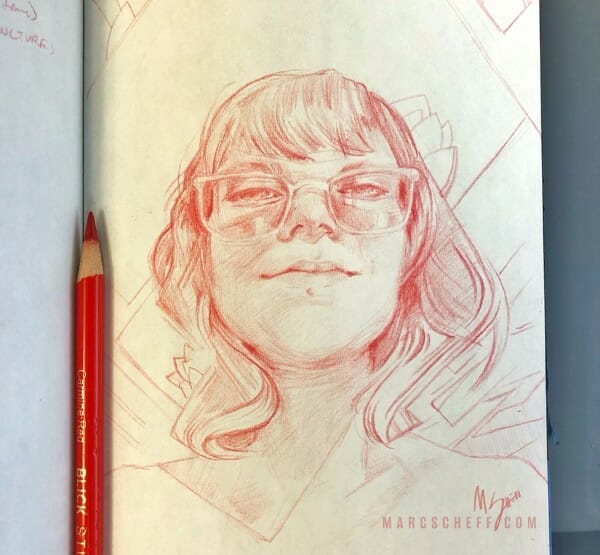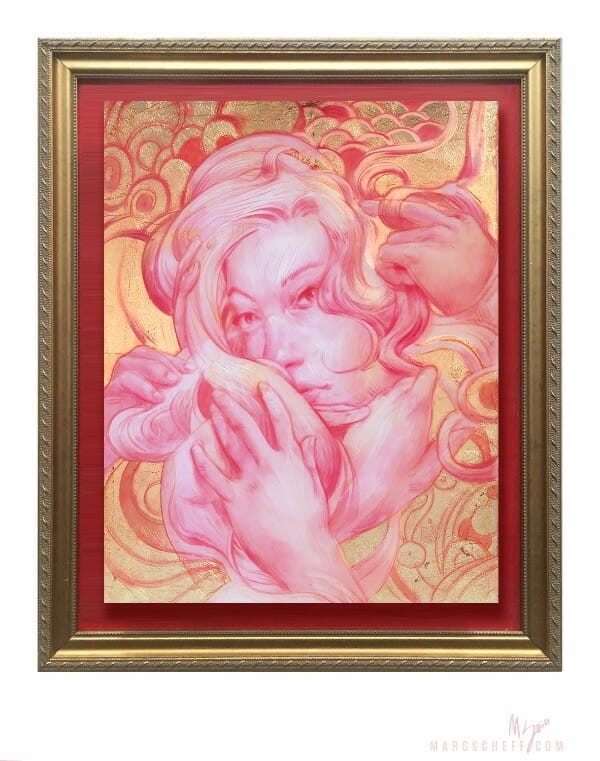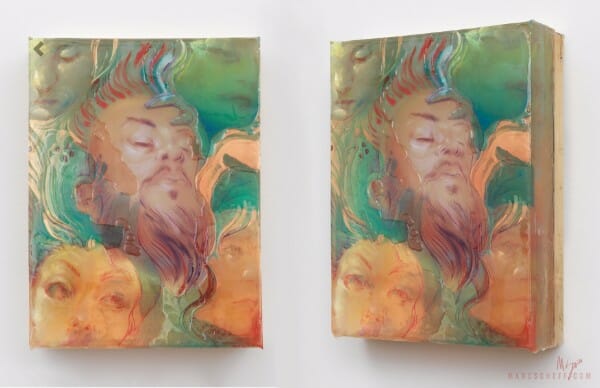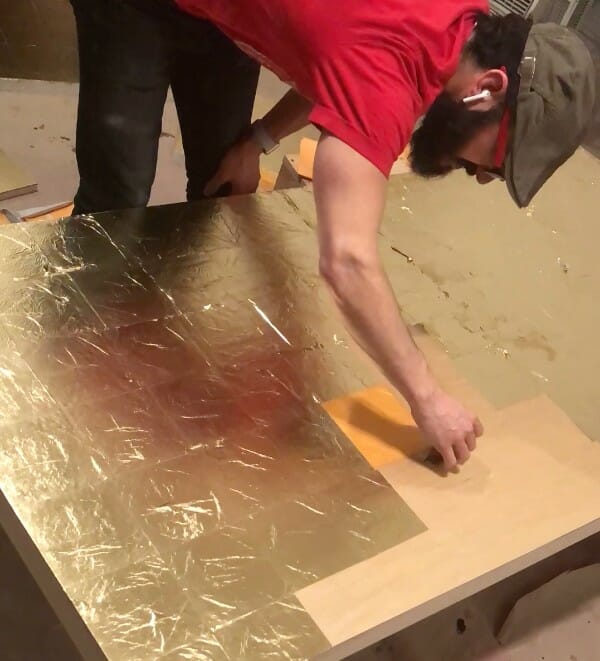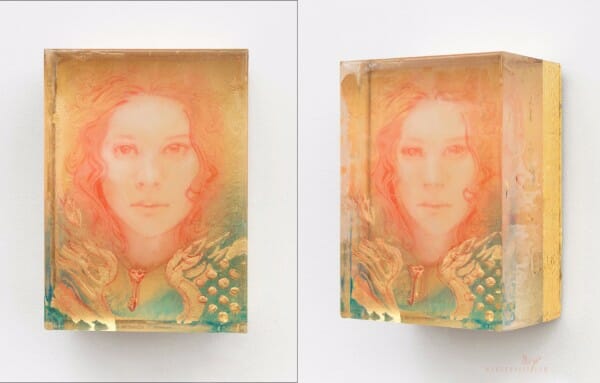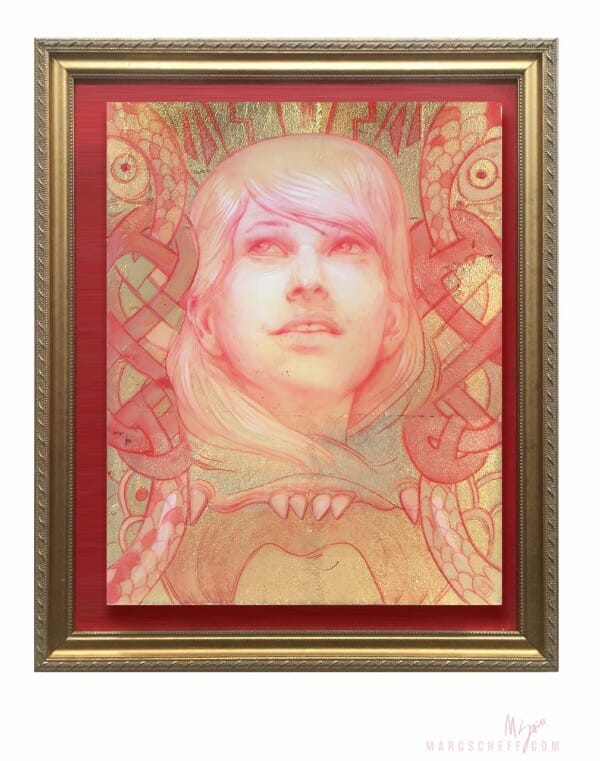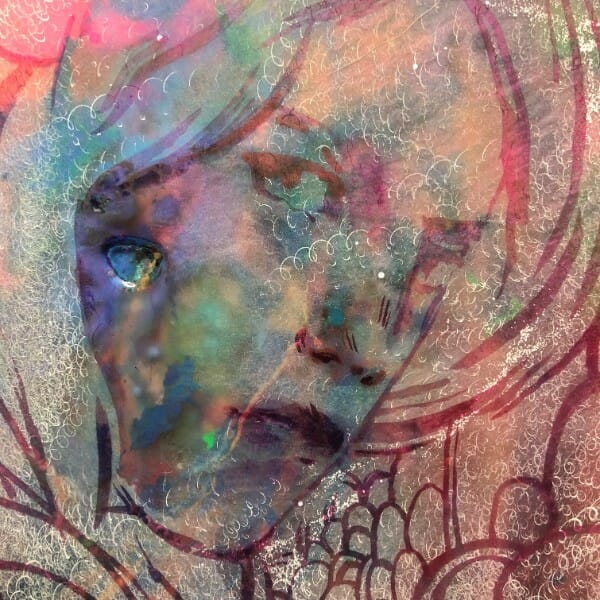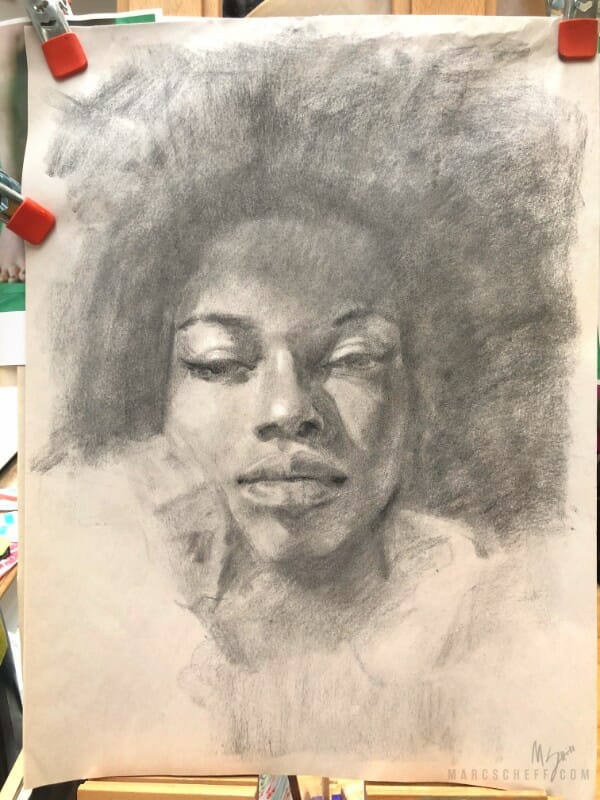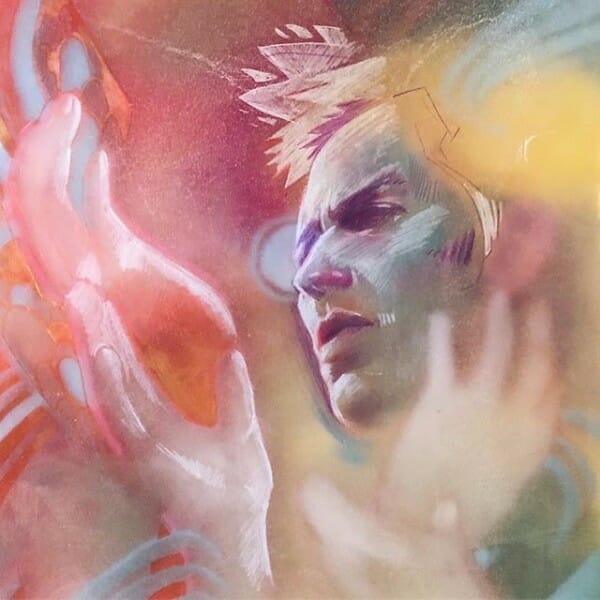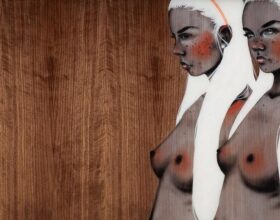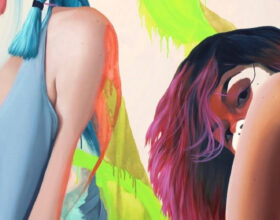We can’t fully extricate ourselves from external factors, like what anyone else does or thinks, or internal ones, like fear, jealousy, rage, and desire. We all do act from these places, whether we choose to face and accept that or not.
And yet we have choice.
Both figuratively and literally, there is a depth to Marc Scheff‘s work. Starting with a drawing, images arise in Marc’s sketchbook. This is already, for most artists getting close to a finished idea, but in Marc’s case, this is a very early part of the layering process that brings his resin woks to life. Marc sees the layers in his work directly relating to our own experiences, both hiding and at the same time as “a window from which we can look”. There are some wonderful insights into Marc’s process in the interview below alongside some more personal narrative. With an upcoming solo show at Haven Gallery “Depth Charge” opening May 19th we can look forward to the full exploration into the art of resin.
You can follow Marc’s work here: Web | Facebook | Instagram | Twitter
Your process for creating your works is a fascinating one. Can you share with us what it entails and a little about your process for bringing these works to life?
I balance two competing urges when I’m working: exploration and mastery. I’ve often wondered what my work would look like if I focused on just a single medium. Rather than bemoan my superior abilities in getting distracted, I have come to accept and integrate my “ooh, something shiny!” tendencies with intention.
My studio is full of different materials, and when I create work I almost always try something new in each piece. It’s easy to go down that rabbit hole of exploration and get lost in what materials can do. However, the heart of my work is my love of drawing, specifically figure-focused. I spend time working on developing my own eye and hand with respect to both draughtsmanship and composition. I go through periods, usually after a show, of intense exploration and study. Then, a frenzy of methodical production based on whatever I just discovered.
In the end, I aim to make new work in new ways and try to make each one better than the last.
In terms of specifics, I have a bunch of sketchbooks and use Photoshop almost every day to plan my work. Digital tools are wonderful for trying out ideas with no risk. What happens after that on the board is always a fun surprise, sometimes just based on what I happen to see or pick up in the studio. I just cracked a bottle of frisket I can’t promise I didn’t get in art school.
And that’s how I discovered ArtResin. I was looking for something at the art store nearby that would seal and finish a drawing and saw some resin on the shelf. The truth is, I didn’t love the drawing and wanted to see if it just needed a finish. So, pro tip: a crappy drawing is still crappy even if you make it shiny.
Still, I saw something in the material and the dimensionality of resin and I began to experiment. I built molds, poured rubber, bought power tools (returned a few), went through hundreds of yards of every kind of tape, and failed more times than I can count.
I do my best to fail forward and find useful lessons and tools in the rubble.
Now I have a number of more predictable techniques and can create work with less worry and still, the core of my work is the image, the drawing, and for my upcoming show “Depth Charge” at Haven Gallery, May 19th I’m focusing heavily on that craft.
You mention in your bio ‘Our exterior and interior worlds guide us, and I examine those unseen layers can you elaborate on the meaning behind these words?
The Stoics say that when everything is stripped away, we have choice. I feel compelled to consider what guides these choices. We can’t fully extricate ourselves from external factors, like what anyone else does or thinks, or internal ones, like fear, jealousy, rage, and desire. We all do act from these places, whether we choose to face and accept that or not.
And yet we have choice.
In the past seven years, I have had a number of external factors, the upside-down turning kind. We had two wonderful kids. My career took an extreme turn and leap with the resin work. I’ve been in galleries that were on my goal list for years from now. I won an award for my work and have had my work and process featured in some wonderful publications, now including Beautiful Bizarre Magazine! I’ve started a few successful side businesses as well, like EveryDayOriginal, that have exceeded my predictions by a wide margin.
And there has been hard stuff as well. I have two kids (they go in both categories), had friendships sour, business ventures stagnate, and frankly dealt with some not-so-fun bouts of my own crippling self-doubt.
It’s easy to get caught up in that external world, however I am also very curious about the internal world that is both a cause and influencer of the external. How do I/we choose to be in the face of success, or failure? Who are we when we don’t like any of our choices? Choosing to do nothing or “acting unconsciously” is also, I believe, a choice we make. This internal world changes constantly. Walt Whitman famously put it best:
Do I contradict myself?
Very well then, I contradict myself;
(I am large, I contain multitudes.) ~ Walt Whitman
and all of that, all the good, the bad, the ever-changing landscape of external and internal, it all goes into the work.
The layers in my work came about naturally and relates directly to the layered aspect of our experiences and our nature. The layers are a window through which we can look, and at the same time, the layers can hide what’s underneath. Some paintings sit on top of complete works, now fully ‘un-seeable’, some just have elements obscured.
We all have secrets, even from ourselves if we choose not to look.
What is your studio like? Do you have any rituals when you begin working?
I feel like I’m the most fortunate guy I know. My wife paints as well and wanted plenty of space for her oil work. We converted the top floor of our home in Brooklyn to be a full office and art studio. The office is where I do a lot of my work and I was doing digital work exclusively for a long time. When I started breaking into ArtResin, I also started breaking in to her side of the studio. I’m very grateful for the space and time I get to make this work.
I’m a student of habit and I survive on ritual. This is my current “good day:” When I wake up, I don’t look at a screen for at least the first thirty minutes of my day. After getting my kids to school, I like to stop at my local cafe and park it for some drawing, often a head study. I also use that time to update a daily journal where I list tasks and projects, ongoing and for that day. That list is my own boiled down version of a number of different productivity tools I’ve studied, and making that list is huge for my productivity. When I get home, it’s slippers, tea and an oil diffuser on full blast. I like to exercise within the first few hours of my workday and my first meal after that. Seven o’clock I hang with my kids, and then I usually spend a little more time in the studio or with my wife.
I have more rituals than I can count, but my favorite one is the one where I get my butt in my chair and draw.
What is the most dominant source of inspiration for your pieces?
I’ll punt this one to Picasso who said, “Inspiration exists, but it has to find you working.”
In terms of artists, I have quite a few that I look to. I just saw the permanent collection at the NYC MOMA and I dare anyone to go look at those Van Gogh’s, Picassos, Miros, Klines, the Wyeth, and more, and not want to run home and make work.
I’m looking more and more at contemporary voices as well, many of whom are now on instagram. Some I like are Arthur Brouthers, Rebecca Guay, Jenny Morgan, Martin Wittfooth, Sergio Barrale, John Wentz, Jana Brike, it’s a long long list. As I plant my feet more firmly in the gallery world, I’m turning my attention there and seeing what people are doing, and there is some truly incredible stuff happening right now with figurative work.
What do you know now that you wish you had known when you were first starting down the path of becoming an artist?
That’s an entire interview! And an easy answer.
I wish I had known more about running a business. You don’t realize how much behind the scenes work is involved in running a business, including marketing, branding, and all the financial stuff. For instance, when and if hiring employees, you must begin a payroll system for them. Manually working out the payroll can take hours of your time, and still result in mistakes (somehow)! Fortunately, there are payroll software services that can deal with this for you, saving you time and leaving no room for mistakes. If I’d have known about services like this when I first became an entrepreneur, it would’ve made my life a lot easier! For the bigger financials in my line of work, I needed to look for an accountant that could help me with the financials of running a business, seeing where they go, and how to manage them in the most efficient way. Recommending to a potential accountant that they should research “DMS for my CPA firm” so that they are able to manage their line of work in a dynamic way that benefits everyone.
I was fortunate again, before art school I earned a degree in computer science and had some tech consulting experience. After art school, my mix of art and science helped me get jobs that paid off my loans fast. But all my experience still wasn’t enough to run my own freelance art career. It took me years of trial and error. I’ve got a truckload of “things I wish I’d known” in this category and it’s not just knowing the steps, there’s a lot of chutzpah involved, stuff that you take for granted in the corporate world. Making friends, making connections, asking for money for your work, paying your taxes, the list goes on.
I even started an education project for artists with my business partner and BFF Lauren. We share information and we pull in other experts to teach courses that help demystify the commercial art world. (MakeYourArtWork.com)
Can we explore the idea of narrative for a moment, can you let us in on what initially got you interested in visual storytelling? What would you say are some of the most important factors that go into making the story successful from the viewer’s perspective?
I seek a balance of narrative and conceptual for my gallery work. I come from illustration and narrative is the point over there. I still love aspects of that work. I always have.
I truly blazed no new trails in terms of childhood interests: I loved comics. I had a neighbor growing up, Matt, and he was a few years older and had TONS of comics. I would climb in his window (which was closer than the front door) and would devour the typical stuff, X-men, Hulk, She-Hulk, Wolverine, Avengers, Spider Man, more than I can list or remember. When I got a copy of “How to Draw Comics the Marvel Way” I dug in and copied as much as I could from that book.
I also tried writing. I remember getting a story assignment in 2nd or 3rd grade to write fiction. The teacher told us that one kid once wrote 100 pages! Teacher’s pet that I was, I decided to write a mystery, a really awesome one, I was certain. I was so stoked. I told the teacher she had her next 100 pager on her hands.
I think I lost steam at 6 pages, ended it on 7 and turned my creative juices back to drawing, where I found it more natural to explore story.
What matters to the viewer that is a moving target. Take Hollywood, visual film narrative. We’ve been told forever that narratives featuring women or black people don’t work. Now look at the biggest blockbusters of the last few years: Black Panther, Wonder Woman, Hunger Games. Success in the 80’s was different than the 90’s, and certainly different from today.
I do think there’s a common factor for successful narratives, and that is the emotional content of the work. I think the viewer can feel when the story has heart, or a deeper meaning to the creator.
What are you currently working on in the studio?
My solo show, “Depth Charge,” at Haven Gallery (May 19th).
Every.
Day.
I’m almost done with the work for the show as I write this and I’m truly excited about what’s happening. Lots of new ideas, colors, and materials, even some frisket, always lots of resin.
Layering plays an important part of your process, can we pick some layers here and ask you to share something we may not already know about you?
Ok, you asked.
As of this writing, I’m on day 39 of 90 sober. By the time anyone reads this, I expect I’ll be well past halfway. Between now and day 90, my focus is on conversations to decide what is next, and how I want to design my life.
You might ask why.
I got to an age (I’m 41) where I was feeling longer-term impacts from a drink or two in the evening, more on weekends. I already juggle a lot, and feeling tired doesn’t make busy work and home life run very well. I got anxious and resented this physical development, the one where my body doesn’t magically bounce back in an hour, and of course that required a drink to manage. Then the poor sleep and then I’m tired. This isn’t good for anyone. Sleep is essential to function properly, however, anxiety is known to have an impact on someone’s ability to sleep and relax. One of my friends tried telling me to look for a new mattress, she thought that I’d be able to fall straight to sleep if I was comfortable. I wasn’t too sure, but it might’ve been worth a go. She said that an Organic Latex Mattress could have enhanced my sleep. Anxiety and not sleeping was slowing me down and reducing my capacity to handle anything.
Honestly, it feels good now and I feel more clear and focused. I feel like I have more capacity to handle surprises.
I also don’t have a crutch, and I’m becoming much more aware of what sharp edges I was dulling with insobriety.
It’s a little frightening to write this here. It feels very, very vulnerable. I don’t know what you’ll think or assume. But this is the work, and our art comes from these stories of our lives. I don’t like to explain my work in detail, when someone asks what a specific piece means. But it all comes from these experiences, struggles and breakthroughs. Some of the work comes from the stories I see around me, this is just one from within.
How do you feel about being a working artist? Can you tell us some of the obstacles you face along with some of the defining moments?
I feel a very intense combination of swelling pride and crippling self-doubt. In college, I decided to study Comp Sci because I thought art wasn’t a viable career. So doing this now, I feel grateful and frankly amazed that I found the path and am walking it with some degree of success.
You ask about obstacles and my biggest one is me.
I think we all have that voice telling us what we’re doing is silly, it isn’t valuable, it’s selfish. I think this goes beyond working artists. We live in a time when so much is changing so fast and the things we always held close to define us are being pulled away, like the job security our parents’ generation assumed. But I get to make art, and there’s that voice demanding to know why do I deserve to do that?!
Two things get me past myself. One is habits. Not goal setting, I don’t buy into goals. If I set a goal of a painting a week, I might do it. But if I come home and have a habit of picking up a brush instead of Facebook, and I do that again tomorrow and again, then obstacles won’t stand a chance.
The second thing is other people. Every defining moment in my life became defining because I listened to someone. I listened to my friend Jason and took a job in SF. I listened to my wife and went to the conference where I heard about the Illustration Master Class. My whole world opened up when I found a whole community of people to whom I’ve listened for years and grown more than I could have dreamed because of it.
In every case it was someone who cared about me and was encouraging me to do something good, for me. I read recently that a good friend is someone who truly cares about you growing and becoming your best self. That rang true, and I’m so fortunate to have many people in my life who fit this description.
So, how do I feel about being a working artist? Fortunate, freaked out, and fabulous.



